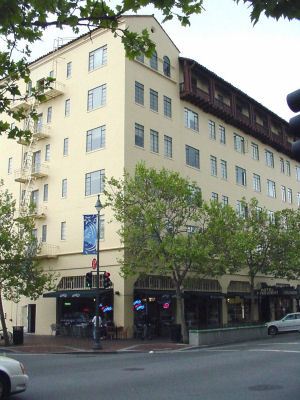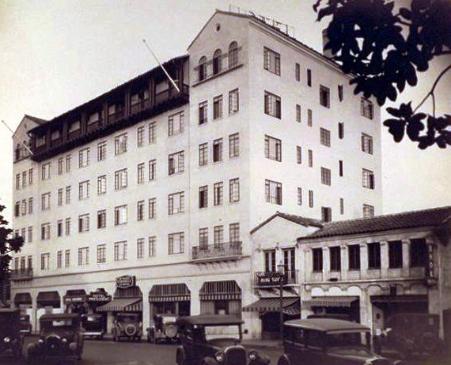The Hotel President: The Class of Palo Alto
In Palo Alto these trends led to difficult years for the city’s two historic downtown hotels --- the Cardinal Hotel on Hamilton Avenue and the Hotel President on University. In the 1950s and ‘60s, auto-friendly motels and resort-style hotels began to pop up along El Camino Real --- then the main thoroughfare for visitors on their way through the city to other destinations. Rickey's the Cabana, Dinah’s Garden Hotel and a line of cheaper options brought stiff competition to Palo Alto’s downtown lodgings. Although the Cardinal was able to survive, The Hotel President met a less dignified fate. Despite efforts to keep up, the Hotel President could not maintain its customer base and was converted into apartments in 1968. It was a sad fate for a hotel originally built as the class of Palo Alto.
The Hotel President’s legacy dated back to 1929. Stanford’s Herbert Hoover was president and the brand new hotel put up on University Avenue reflected the city’s pride in their local hero. The Hotel President, designed by another local --- architect Birge Clark--- was six stories tall and contained 125 rooms. Built in that decade’s trendy Spanish Colonial Revival style, the Hotel President boasted a lush roof garden, a beautiful beamed ceiling lobby and a grand spiral staircase that climbed all the way to the top floor. A brochure from the era, advertising the hotel’s “gracious living,” pointed to its “large, comfortably furnished guestrooms,” each of which had “outside exposure and a private bath.” The hotel even featured in-room radio service, allowing guests to choose between channels as they showered, shaved, or relaxed in their suite.
But after decades as Palo Alto’s fashionable place to stay, the President began to falter in the 1950s. As Downtown began to lose shoppers in the 1960s, Palo Alto’s leaders feared that University Avenue could suffer an economic collapse. Some of the policy changes they experimented with had a negative impact on the Hotel President. For instance, the city’s brief move to make University Avenue a one-way street hurt business at the hotel. New signing restrictions were also detrimental, according to the owners at the time. The Hotel President was forced to take down its enormous rooftop sign, making it more difficult for out-of-towners to find the hotel.
Additionally, the modernist mini-skyscraper built caddy-corner to the Hotel President at 525 University demoted the hotel’s prominence on Palo Alto’s skyline. It also suffered from the end of the Lark and the Daylight, Southern Pacific’s Los Angeles to San Francisco trains that once stopped the base of University Avenue and brought tourists to stay at the Hotel President.
After the hotel converted to studio apartments and became the “President Hotel Apartments,” a predictable decline began. Over the course of the next few decades, the building became a sad version of its former self. As it aged, improvements were foregone and the rooms that were luxurious for 1930s guests, now seemed stiflingly confined and aged as modern-day apartments.
In 1985, a new luxury hotel, the Garden Court Hotel was built next store --- a cruel irony for the Hotel President, as the classiest place to stay in Palo Alto moved next door. Renters at the apartments despaired, first from the construction noise next door and later because of the chimney smoke that rose from the Garden Court’s in-room fireplaces into the windows of the apartment dwellers above. Many renters abandoned the apartments --- leaving mostly elderly residents dependent on monthly Social Security checks to occupy the President.
Today the Hotel President still stands, a collection of studio apartments in a once-again fashionable (and expensive) neighborhood to live. But now the President sits quietly, no longer an icon and perhaps a bit too withdrawn, especially for a landmark that once proudly identified itself in letters so big that all of Palo Alto could see. []
Our Reader's Memories:
"Upon moving to Palo Alto as a child in 1955 with my parents we stayed at the hotel for a month or so while my mom spent her days finding us a house and my dad establishing his first office in town on Homer Ave. I remember it as being a friendly place with a beautiful lobby. Palo Alto's University Ave. was a sleepy street with not too much activity. I also rememeber that the Toy World toy store was right across the street.
"-Celeste
Contact Us
"We stayed at the President in the Spring of '52 while my parents shopped for a home in the area. Since my dad was in the hotel business and on a first-name basis with the owner/operator, I also was given the chance to occasionally work as a bellhop. The restaurant was still fully functional at the time. Upon returning a couple of years ago, it was sad for me to see the decline in the building's appearance and presence on Palo Alto's main thoroughfare. "
-Hal


The Hotel President in the 1930s. (PAHA)

The rooftop sign is evident in this Dedication Day Parade photo from 1941. (PAHA)

The Hotel President lobby as seen in 1958. (PAHA)

The Hotel President in the 1930's as viewed from Cowper Street. (PAHA)